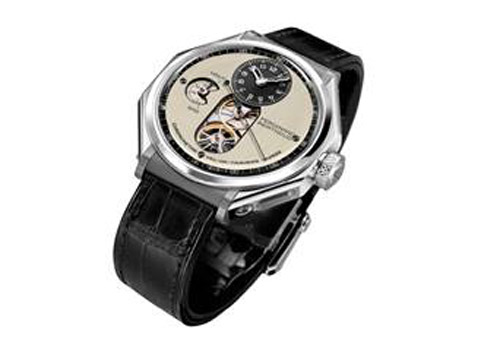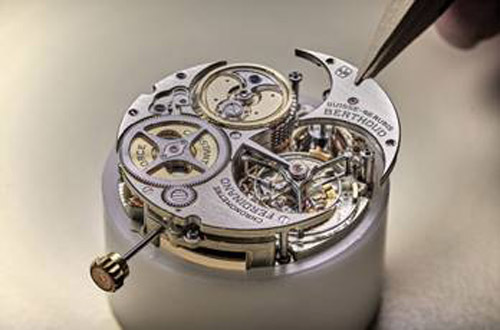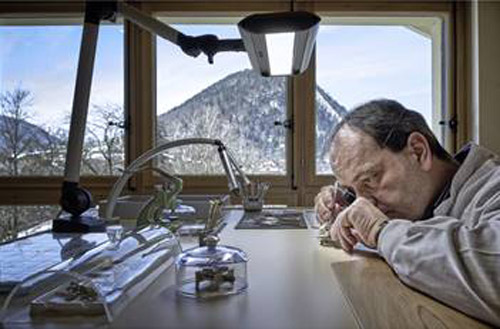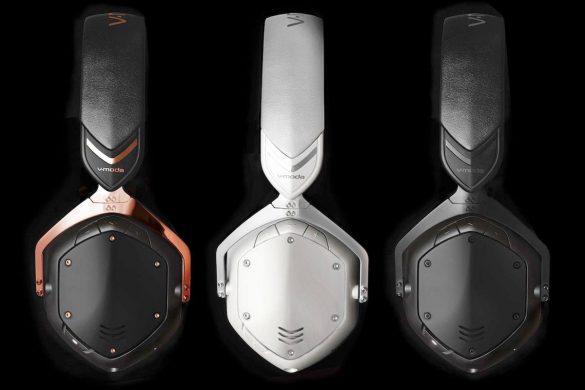Born from an approach that is unique in the world of modern watchmaking, the new Chronomètre Ferdinard Berthoud FB 1.3 is the most exclusive to date, coming on the heels of the FB 1.1 chronometer that won the “Aiguille d’or” Grand Prix award at the 2016 Grand Prix d’Horlogerie de Genève, and the FB 1.2. Distinguished by its unique shape and complexity, the platinum case frames a partially openworked nickel silver dial featuring an understated and distinctive play on colours. Its movement is endowed with complications inspired by the 18th century Ferdinand Berthoud chronometers that served as reliable scientific instruments.

Ferdinard Berthoud – FB 1.3
Nonetheless, even terms such as “suspended tourbillon”, “constant force” or “fusee-and-chain transmission” cannot begin to express the true sophistication of this exceptional calibre. The philosophy driving Chronométrie Ferdinard Berthoud cannot be summed up as a tribute, a reproduction or even a reinterpretation, since it is in fact far more demanding. It embodies a contemporary translation of the quest for excellence pursued by the master horologist who was appointed clockmaker to the French King and the French Navy.
The Chronomètre Ferdinard Berthoud FB 1.3 picks up all the aesthetic and technical features of the previous versions that were respectively crafted in 18-carat white gold (FB 1.1) and 18-carat rose gold (FB 1.2). The 44 mm-diameter case of this watch sits naturally and comfortably on the wrist. Composed of a 950 platinum cylinder housing the movement, it comprises two octagonal-shaped side pieces in polished platinum that contribute to its distinctive shape. The latter is inspired by an overhead view of a marine chronometer fitted inside its case: its round shape is cut through by the arms of the gimbal suspension that holds it in place when the ship is at sea. The grey ceramic lugs are secured to the case middle by two stylised titanium bolts marking the starting points of the hand-stitched double-sided alligator leather strap. The same ceramic is also present on the medallion adorning the knurled platinum crown. Finally, four ‘portholes’ cut out from the sides of the case provide a chance to admire the fusee-and-chain mechanism in action, as well as to allow light to flood through the movement.
Another opening in the satin-brushed nickel silver dial reveals the wheel driving the tourbillon carriage and the seconds wheel to which the central seconds hand is fitted, an unusual feature on a tourbillon. This slim black hand sweeps around a translucent sapphire railtrack circle around the rim of the dial. The hours and minutes are offset at 12 o’clock on a black lacquered subdial bearing white Arabic numerals and white gold cut-out hands. The same black shade also graces the chamfered edges of the dial openings. The nature and origin of the Chronomètre FB 1.3 are also indicated on this large dial that is engraved with the inscription “Chronomètre Val-de-Travers Suisse”. Far more than merely representing a signature or an appellation of origin, it proudly proclaims the model’s identity.

Ferdinard Berthoud – FB 1.3
The way the FB-T.FC calibre is built is a truly unique phenomenon on the contemporary watchmaking scene. This hand-wound movement features 15 bridges and three half-bridges in nickel silver, framed by polished titanium pillars surrounding the mechanical organs. This construction is typical of 18th century marine chronometers, and enables the portholes of the Chronomètre Ferdinard Berthoud FB 1.3 to reveal the interior of the watch. Equally high aesthetic standards apply to the design of all components, and especially to the symmetrical visual balance characterising the various sets of components.
This movement is one of the rare examples to feature a fusee-and-chain transmission, which is the oldest historical solution developed to ensure constant force for the escapement. This system acts like an automatic gear box, with the torque delivered by the barrel varying according to the level of winding.
When the movement is fully wound (53 hours of power reserve), the chain is entirely coiled around the small end of the fusee and the barrel spring is at maximum power. At just 7.96 mm thick, the movement powering the Chronomètre Ferdinard Berthoud FB 1.3. is the thinnest in its category and a patent has been duly filed for this construction.
The Chronomètre Ferdinard Berthoud 1.3 is produced in a 50-piece limited numbered series.

Ferdinard Berthoud – FB 1.3










